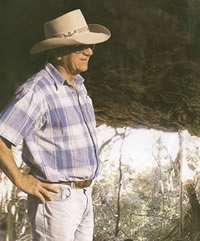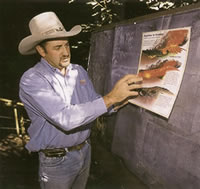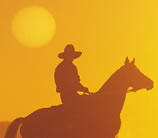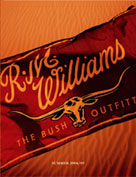OUTBACK PEOPLE
Tunnel vision
Story Julie Miller
Photos John Denman
 In political
circles, the title "elder statesman" is not lightly bestowed.
Mandela, yes. Whitlam - possibly the only local candidate. Clinton - not
in this lifetime. For the term implies more than just longevity and success.
It requires passion, a quiet conviction, versatility and endurance, and
a person who commands respect.
In political
circles, the title "elder statesman" is not lightly bestowed.
Mandela, yes. Whitlam - possibly the only local candidate. Clinton - not
in this lifetime. For the term implies more than just longevity and success.
It requires passion, a quiet conviction, versatility and endurance, and
a person who commands respect.
In the microcosm of Far North Queensland, a cattleman from the middle of
nowhere seems an unlikely contender. But that's exactly what Gerry Collins
is - an elder statesmen of the region's burgeoning tourism industry. With
his distinguished grey hair and proud bearing, he appears as comfortable
in a tuxedo as he does in a Driza-bone, and is as composed accepting an
award at a major function as he is leading groups of tourists through his
beloved Undara Lava Tubes.
For Gerry Collins, it depends which hat he's wearing - and he is a man
of many hats.
Just below the grasslands of the gulf savannah country near Mt Surprise
in
lie the spectacular Undara Lava Tubes, recognised by the scientific community
as the largest, longest and most important lava tunnels on the planet.
They began some 190,000 years ago when a major volcano blew its top, spewing molten lava into nearby dry river beds. The external lava cooled quickly, forming a crusty layer. But in the fiery realm of Hades, a fierce river of lava forged a path downstream, creating long, dark, hollow tubes. The outpouring of molten liquid was massive - covering 1550 sq. km of land.
After the insulated lava drained away, the legacy was a natural pipeline more than 100km long.
 The lava from
the Undara volcano travelled 164km to create the longest lava flow from
one single vent in modern geological time.
The lava from
the Undara volcano travelled 164km to create the longest lava flow from
one single vent in modern geological time.
Some of the tubes are still fully enclosed, dark and eerie caverns feared
and shunned by local Aboriginal tribes. In some parts, however, the ancient
roof has collapsed, creating fertile pockets of rainforest where rare species
of plants, animals and insects now thrive - euros, rock wallabies, bettongs,
bats, cave moths and the birds of the night that flock to gorge on them.
It's a delicate, finely balanced environment, untouched for thousands
of years, a veritable buried treasure. Today, the lava tubes are protected
by the Queensland Parks and Wildlife Service, which allows public access
under supervision of savannah guides from the Undara Experience - the people
who know this land best. ![]()
Full story: Issue 20, December 01 / January 02


